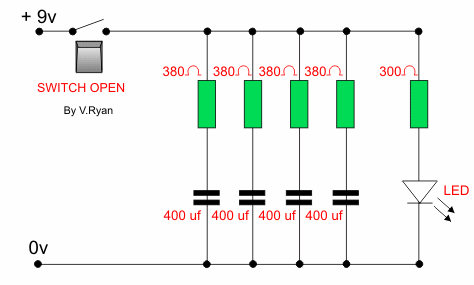The kinetic challenge was a project that asked us to keep an LED lit as long as possible by storing kinetic energy. I attempted to make my own gearing for a DC motor that would generate enough electricity to not only power an LED but charge several capacitors as well.
To prove the concept I started by using a 9V battery as the power source. This made it easy to test the capacitors and experiment with different components to maximize the discharge time.
I found this schematic on technologystudent.com which suggested that a resistor in series before each capacitor would lengthen the amount of time it took for each capacitor to discharge.
I tried it out and it did improve my results, so my circuit essentially looked like the diagram, except for differing resistor values (220 Ω before each capacitor and 1 kΩ before the LED). The capacitors were 4,700 µF (4.7 mF), the largest capacitance I could find in the shop. The first photo is of the circuit without the resistors.
The last step was to create a gearing that would allow a crank to generate a sufficiently high, smooth voltage into the capacitors. I made a larger gear by hand that was meant to work with the gear that was permanently attached to the motor; however, the gear was far from perfect and I also ran into problems physically mounting the system.
In the end the system failed. I don't have a picture to illustrate this but the setup was not sufficient to power the LED, even by bypassing the capacitors. I learned that testing with ideal power sources can be both a blessing and a curse because it can cause you to overlook the fact that a large part of your system is not being sufficiently vetted for feasibility. On the other hand I now have a better grasp of how to control an electric source, which will undoubtedly come in handy in the solar challenge coming up next.





No comments:
Post a Comment
Speak now...